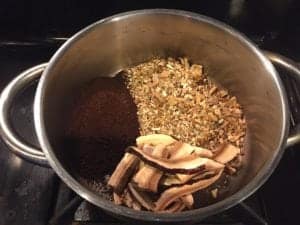notCoffee is notBad!
As promised in the post about moving your body in spite of body issues, here is my recipe for notCoffee. No, it’s not coffee. But it’s not bad! In fact, I LOVE it!
Katja’s notCoffee formula
I mix roughly equal parts of the following rooty herbs:
per 2.5 quarts of water, i use 1-2 tablespoons of each
- Ashwagandha (plus a little extra)
- Spikenard
- Codonopsis
- Dandelion or Burdock root
And a little less of these rooty herbs:
per 2.5 quarts of water, i use shy of 1 tablespoon of each
- Calamus
- Angelica
- Elecampane
- Solomon’s Seal
- Reishi (1-2 slices, chopped up a bit)
Then, I add a few tablespoons of Equal Exchange decaf coffee. (If you want it to be notCOFFEEEEEE!, use more decaf. If you are happy with a rooty notCoffee beverage, use less decaf, or none!)

brewing it up
Add water, and bring to a boil. Then simmer for a while, then enjoy! I like mine with unsweetened Almond Milk.
I typically just leave this on the stove all the time. The first 5 or so cups that I drink, I immediately refill the pot – these are all roots, so you can actually add water for a while! I find that if I add the water right away, just a cup at a time, instead of waiting until the pot is half empty, the flavor is better and doesn’t get “thin” tasting.
about the ingredients
Why these herbs? I don’t do well on caffeine, so I was looking for herbs that would as closely mimic the flavor as possible while providing my body with a real boost, instead of a caffeine boost. And it works!
Here’s a bit about each one, with my favorite fun facts:
Ashwagandha: True, it’s an “adaptogen”, but Ashwagandha is more about cycle than anything. Think, energy in the daytime to do what you have to do, and good solid sleep in the nighttime so you can do it again tomorrow. I seriously *love* Ashwagandha.
Spikenard: Although it’s in the Ginseng family, it’s not so zingy as Ginseng. Which is good – if I get a big boost of “artificial” energy, I just want more. I like Wild Sarsaparilla too, and swap these out interchangeably depending on which one I have.
Codonopsis: Also a slow-build energy herb. It’s not so much about the power boost as it is about the foundational build, and I love that.
Burdock or Dandelion root: Great for your liver, and great for your probiotics! Both roots have inulin, a prebiotic – or in other words, food for your friendly flora!
Calamus: An excellent digestion aid, Calamus is really in the mix because it helps you get emotionally grounded, and especially when my mind gets to spinning with my crazy to-do list, I really need that.
Angelica: In Iceland, the Angelica is as tall as I am. Angelica loves extremes and knows full well how to thrive in them. I’m all about making lots of changes in your life so that you can live not so much in the extreme zone, but our culture doesn’t make that very easy. So while I’m working on it, Angelica is there to help!
Elecampane: Traditionally seen as a respiratory herb, Elecampane is multi-talented. Yes, it’s a boost against the respiratory gunk going around. But also, a digestive aid and emotionally, Elecampane helps you make shifts in your life – kind of like it helps you cough up the gunk out of your lungs!
Solomon’s Seal: Balance and flexibility, physically and emotionally. Because of course, where do we hold our emotions but in our body? Solomon’s Seal is excellent for keeping joints lubricated and the fascia happy, which leads to a more sure-footed you, even on uneven ground!
Reishi: I think there could be a whole book just about Reishi. But one of the things I particularly loved when I read it was that Reishi helps balance the rational and the emotional minds. Yes, please! Oh, there’s lots of great other effects that have been well-documented over the years (going back thousands of years actually in Chinese medicine!), but on my average morning, I know that finding that balance is going to make my day a lot more effective!
Learn more of Katja & Ryn’s favorite formulae in our Fundamentals of Formulation course!
2 Comments
Leave a Comment
You must be logged in to post a comment.

Join our newsletter for more herby goodness!
Get our newsletter delivered right to your inbox. You'll be first to hear about free mini-courses, podcast episodes, and other goodies about holistic herbalism.


Are these roots in chunky form or is powdered okay? As in, what if my local herb shop only carries powdered ashwagandha powder?
yep – chunky form! i like to call it “confetti”, and sometimes you’ll see it called “cut and sifted”.
if you only have powdered, that’s ok! in that case, maybe you make it in a french press! but you can make more than one pot with the same powder! or, you can go ahead and boil it in a pot with the powder too, just use a fine strainer when you ladle it out 🙂
and, if you wish you had the chunky kind, just ask your local herb shop to get that but if they can’t, you can check mountainroseherbs.com and see if they have it in stock.